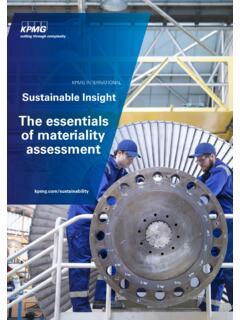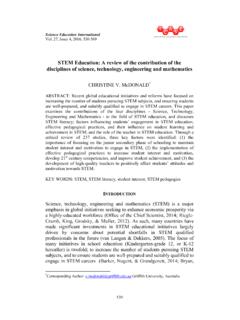Transcription of Cooperative Learning: Review of Research and Practice - ed
1 Australian Journal of Teacher Education Volume 41 | Issue 3 Article 3. 2016. Cooperative learning : Review of Research and Practice Robyn M. Gillies University of Queensland, Recommended Citation Gillies, R. M. (2016). Cooperative learning : Review of Research and Practice . Australian Journal of Teacher Education, 41(3). This Journal Article is posted at Research Online. Australian Journal of Teacher Education Cooperative learning : Review of Research and Practice Robyn M. Gillies The University of Queensland Abstract: Cooperative learning is widely recognised as a pedagogical Practice that promotes socialization and learning among students from pre-school through to tertiary level and across different subject domains. It involves students working together to achieve common goals or complete group tasks goals and tasks that they would be unable to complete by themselves. The purpose of this paper is to Review developments in Research and Practice on Cooperative learning and to examine the factors that help to explain its success.
2 In particular, the Review focuses on the key elements that contribute to its success and the role teachers play in developing students' thinking and learning when implementing this pedagogical Practice in their classrooms. Background Research on Cooperative learning Interest in Cooperative learning gathered momentum in the early 1980s with the publication of the first meta-analysis involving 122 studies on the effects of Cooperative , competitive, and individualistic goal structures on students' achievement and productivity in a sample of North American schools (Johnson, Maruyama, Johnson, Nelson, & Skon, 1981). The results showed that cooperation was more effective than interpersonal competition and individualistic efforts; cooperation with intergroup competition was also superior to interpersonal competition and individualistic efforts; and, there were no significant differences between interpersonal competitive and individualistic efforts. Moreover, these results were consistent across all subject areas (language arts, reading, mathematics, science, social studies and physical education), for all age groups, and for all tasks involving conceptual understanding, problem solving, categorizing, and reasoning.
3 In a similar vein, Slavin (1989) reported on a best-evidence synthesis of 60 studies across both elementary and secondary schools that compared Cooperative learning to control groups studying the same material. The results showed that the overall effects of Cooperative learning on achievement were clearly positive in 72% of the comparisons whereas only 15% favoured control groups with 13% recording no significant differences. These findings led Slavin to conclude that Cooperative learning can be an effective strategy for increasing student achievement. In a follow-up meta-analysis of 117 studies that was conducted on the learning Together and learning Alone method (Johnson & Johnson, 1994), Johnson and Johnson (2002) examined the effects of Cooperative , competitive, and individualistic learning on a number of academic, personal and social dependent variables ( achievement, interpersonal attraction, social support, self-esteem, perspective taking, learning together, and controversy).
4 And found strong effect sizes between Cooperative learning in comparison to competitive and individualistic learning . These effect sizes ranged from to or effect sizes that Hattie Vol 41, 3, March 2016 39. Australian Journal of Teacher Education (2009) believes are desirable because they can make real world differences (p. 17) in educational interventions. In short, the results of this meta-analysis and the Johnson et al. (1981) meta-analysis and Slavin's (1989) best-evidence synthesis found that Cooperative learning in comparison to competitive and individualistic learning has very strong effects on a range of dependent variables such as achievement, socialization, motivation, and personal self-development. Given the findings from these meta-analyses (Johnson et al., 1981; Johnson &. Johnson, 2002; Slavin, 1989) that have highlighted the academic and social benefits students derived from working cooperatively together, Roseth, Johnson and Johnson (2008) examined the social-contextual view of the mechanisms and processes by which these benefits are promoted.
5 In a meta-analysis of 148 studies that compared the effectiveness of Cooperative , competitive, and individualistic goal structures in promoting early adolescents' achievement and peer relationships, Roseth et al. found that higher achievement and more positive peer relationships were Cooperative rather than competitive or individualistic. Furthermore, Cooperative goal structures were strongly associated with early adolescents' achievement and positive peer relationships. In short, the more early adolescent teachers structure students' academic goals cooperatively, (a) the more students will tend to achieve, (b) the more positive students' relationships will tend to be, and (c) the more higher levels of achievement will be associated with more positive peer relationships (Roseth et al., p. 238). In a follow-up meta-analysis that investigated the degree to which achievement is positively associated with motivation in positive ( students are linked together to achieve goals), negative ( students compete to achieve goals), or no interdependence ( students work individually) situations, Johnson, Johnson, Roseth and Shin ( 2014 ) found that situations characterized by positive interdependence resulted in greater motivation and achievement than did negative or no interdependence situations.
6 In a best evidence synthesis of Research on primary and secondary mathematics and reading and programs for struggling readers, Slavin (2013) found that well-structured methods such as Cooperative learning produce more positive effect sizes than those evaluating other instructional practices such as the use of innovative curriculum text books or the use of technology in reading and mathematics. Similar results were obtained in a best- evidence synthesis of elementary science programs by Slavin, Lake, Hanley, and Thurston ( 2014 ) who stated that: science teaching methods focused on enhancing teachers' classroom instruction throughout the year, such as Cooperative learning and science-reading integration, as well as approaches that give teachers technology tools to enhance instruction, have significant potential to improve science learning (p. 901). In short, there is overwhelming evidence that Cooperative learning as a pedagogical Practice has had a profound effect on student learning and socialization (Slavin, 2014 ).
7 What Accounts for the Success of Cooperative learning ? Placing students in groups and expecting them to work together will not necessarily promote cooperation. Group members often struggle with what to do and discord can occur as members grapple with the demands of the task as well as managing the processes involved in learning such as dealing with conflicting opinions among members or with students who essentially loaf and contribute little to the group's goal (Johnson & Johnson, 1990). In order to avoid these pitfalls, Johnson and F. Johnson (2009) propose that groups need to be Vol 41, 3, March 2016 40. Australian Journal of Teacher Education established so that the five key components of successful Cooperative learning are embedded in their structure. The first of these key components involves structuring positive interdependence within the learning situation so all group members understand that they are linked together in such a way that one cannot achieve success unless they all do, and they must learn to synchronize their efforts to ensure this occurs.
8 Deutsch (1949) found that cohesiveness develops in the group as a direct result of the perception of goal interdependence and the perception of interdependence among group members. Positive interdependence is established in groups when students understand that they are each responsible for completing a part of the task which, in turn, all must achieve in order for the group to complete its goal. Teachers can ensure that this occurs by assigning different parts of the group's task to different group members to complete (Johnson & Johnson, 2002). The second key component for successful cooperation is promotive interaction or the willingness of group members to encourage and facilitate each other's efforts to complete their tasks in order for the group to achieve its goal. Johnson and Johnson (1990) noted that promotive interaction is characterised by students: providing each other with the help they need; sharing needed resources; providing effective feedback to group members on their performances on specific tasks; challenging other's conclusions and reasoning in order to promote clearer insights into the problem issue; and, working constructively together to attain mutual goals.
9 In so doing, students develop an awareness of what others do not understand and the need to provide explanations or assistance that can be readily understood. Willingness to engage with others not only benefits recipients but also helpers as giving help encourages helpers to reorganise and restructure the information in their own minds so they, in turn, develop clearer and more elaborate cognitive understandings than they held previously (Webb & Mastergeorge, 2003). Teachers can facilitate interaction in groups when they ensure students sit in close proximity to other group members so they can hear what is being discussed, see each other's faces, and participate in the group's discussion. When students are provided with opportunities to interact with their peers during small group discussions, they learn to read each other's non-verbal language, respond to social cues, and engage in general banter about the work they are completing (Gillies, 2003a,b).
10 The third key component is individual accountability or one's responsibility in ensuring that he or she completes his or her share of the work while also ensuring that others complete theirs. In fact, the more students perceive they are linked together, the more they feel personally responsible for contributing to the collective effort of the group. Johnson and Johnson (1990) maintain that teachers can establish individual accountability in two ways: firstly, by structuring positive interdependence among group members so they will feel responsible for facilitating others' efforts; and secondly, by holding students personally responsible for completing their part of the task and ensuring that their contributions can be clearly identified. Assigning students to groups and expecting them to know how to cooperate does not ensure that this will happen. In fact, groups often implode because they lack the interpersonal skills required to manage disagreements among group members.















